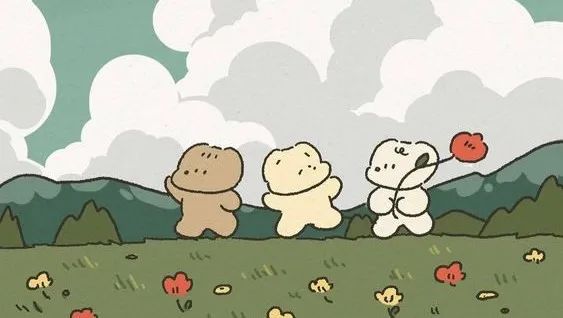"It looks harmful, but in fact it is good for you" eight small things "
Author:Knowing my psychology Time:2022.08.01
In life, we will inevitably experience some bad things. Some things seem to only make us pain and have no value. In fact, from the perspective of psychology, they still have a positive impact on our personal growth and life.
We want to introduce you to 8 things that seem harmful but are actually valuable to us. They are not uncommon in our lives. I hope that when you understand their value, if you encounter it again, you can greet them more frankly and easily, letting them flow through you, and no longer consume you.
1. Cognitive collapse
When we encounter the harm of loved ones in our lives, the broken three views in love, the betrayal of friendship, etc., we will feel that the beliefs established in our minds based on past life experience have been overturned. The collapse of this cognition will make us feel the sense of emptiness, helplessness, and confusion of the future, and may even be difficult to get up.

However, psychological studies have found that although this will be a painful memory, the subversion and subsequent reconstruction brought by the cognitive collapse will bring accidental gains.
Reconstruction of our cognition will allow us to build a higher psychological prosperity. Our psychological, physical and social ability will increase, supporting us to live better in the future (Carver, 1998).
At the same time, the reconstruction process of cognition has also enhanced our psychological elasticity -the process of adapting to individuals facing adversity, dilemma or large pressure events. In the future, when we face setbacks again, we will have stronger emotional adjustment capabilities to adapt to the current situation (Carver, 1998).
More importantly, you will find that you are stronger than you think, you can rely on yourself.

2. immerse in sadness
When we are immersed in sadness because of some things, the people around us will comfort us, hoping that we will come out as soon as possible, and even we will tell ourselves to tell ourselves. Because of many people, sadness is a negative emotion that harms our physical and mental health and has no help to actual problems.
However, a study found that after 97 college students completed the crying diary of 40 to 73 days, 30%of them had positive emotions, and the stronger the crying could bring more positive emotions. This may be because immersive immersion Can better help us vent their emotions in sadness (byLsma et al., 2008).
At the same time, sadness is a more infectious emotion that can help us enhance psychological links with people around us. Those who have shared pain with you will make you feel close and safe.
Sadness also increases our attention and memory of details in the environment. A study found that passive participants with emotions can more accurately remember the original details, ignore misleading information, and more errors made by emotional participants. This is because happiness is easy to cause a person's attention, so it has increased the chance of misleading information to be included in memory (Forgas, 2014).
3. Better halfway
The education we often receive from a young age is often not to be abandoned halfway, and even if a person can insist on whether it can endure the hard work with TA and whether it is excellent.
So sometimes we obviously want to give up and feel that it is a matter of persistence to persist in a swollen face, and we dare not face this idea, and even think about giving up this option. middle.
However, WroSch and Miller wrote in the magazine of "Psychological Science": "When people find themselves that they are unlikely to achieve their goals, giving up may be the most adaptive decision. By giving up a target that cannot be achieved, a person can be alone. Avoid repeating failures and its influence on the body and mind. "
Similarly, research shows that leaving the goal (Goal Disengagement) can be a healthier choice and an important psychological ability, because we can put limited energy in more meaningful things now, and then Not immersed in the past goals.
Therefore, when we face the goal that we cannot rely on persistence, it is not shameful halfway. Knowing what time and how to let go are the wisdom we need to master. (And you can also choose to adhere to the goal scientifically))

4. The anger that cannot be restrained
In universal concepts, anger has always been a strong, devastating negative emotion. Those who are easy to get angry often feel the discomfort of the body, but also cause pressure on others, giving people a sense of trusting and difficulty in getting along.
Is that anger is not good? Angry can actually bring strength to people and let us build a complete self. In this era of suppressing inner needs, anger allows us to better claim our rights, needs and desires when being interfered by others (Lerner, 2014; P.2). Angry is also an important weapon for our personal boundaries, and teach others to "how can TA treat us" with anger.
In addition, anger will inspire a person to bear more responsibilities. Social psychologist Jennifer S. Lerner and her colleague Dacher Keltner did an experiment to let the subject choose who sacrificed in a disaster. It was found that angry people were willing to bear more risks in order to save more people, and compared to those who felt scared, even if they sacrificed more people, the TAs were even more willing to bear the risks (Lerne & Keltner, 2001). This study also found that angry people and optimistic people will have the same choice (Lerne & Keltner, 2001), and the reason behind this is because they are more optimistic.
It can be said that anger is not only a manifestation of against the outside world, but also a belief in looking forward to things and turns.
5. It's easy to worry about encountering things
We often feel that anxiety can cause us to have bad performance, missing a lot of opportunities, and at the same time anxiety is also an immature and insufficient bearing ability.
In fact, people who are easy to anxious have many advantages.
A survey of a sport showed that anxious students and professional athletes performed better when participating in competitive competitions (Hardy & Hutchinson (2007). It may be because facing challenges will make a person more motivated and more prepared.
Another report shows that when people are anxious, they can accept information more objectively and make better decisions (Garrett et al., 2018). Anxiety helped you see the two sides of the matter and let you have more comprehensive information.
However, if your anxiety is serious enough to start affecting your normal life, you can also try the "Professional anxiety tendency manual" produced by KY evaluation. In this evaluation, we will help you dig the deep causes of your anxiety and give you some suggestions on your situation to relieve anxiety. Long press to identify the QR code to find the evaluation:
If you have a friend who is easy to be anxious, you will find that TA has more empathy and understanding than others (Tibi-Elhanany, 2011). This is because the TAs used to have a high probability that they also experienced such inner struggles, so when friends and family members encountered the same thing, the TAs would be more sensitive and accepted. (Editor: It seems that anxiety is really a characteristic.)
6. Fierce quarrel
A quarrel is a very emotional thing to many people. We will worry that the tension and differences in the quarrel, and the fierce words will hurt this relationship.
However, some studies have found that although the quarrel with the partner may cause discomfort in the short term, a honest conversation will occur during the quarrel, and in the long run, it is beneficial to the relationship. His quarrel is also a very important form of running -in in the intimate relationship.
Similarly, a report in 2019 shows that a happy couple does not mean that there is less quarrel, but TAs are good at solving their disputes by quarrel (Rauer et al., 2020). So, if you are not in good feelings, don't let the quarrel simply.
In fact, when the quarrel, the other half freely put forward their own disappointment and dissatisfaction, express their views in person, and increase the understanding of each other's bottom line. Instead, it will strengthen the relationship between you without leaving room for resentment.
7. Habitual delay
Procrastination is often regarded as a bad habit, and people who habitually delay will leave an unreliable impression.
However, a study analyzed the number and delay of the number of videos released by YouTube creators, and found that when the TAs were moderate delay, their videos were the most creative. This shows that moderate delay can allow people to generate inherent motivation and have the opportunity to generate new ideas, so that the video is more creative (Shin & Grant, 2021).
In addition, the procrastination has also given us some time, allowing us to have more time to think and make more appropriate choices before acting (Chauhan et al, 2020).
Another advantage of procrastination is that the boring job can be excited due to time tension, which will increase your potential work motivation and help us work more focused (Kim & SEO, 2013). In addition, if a person is procrastinating, he can also complete the work at DDL, which will increase the sense of self -efficacy of TA and believe that he is capable of effectively completing the work (liu et al., 2017).
8. Less options

Fewer choices seem to be reflected by a person's ability and resources, but in fact, choosing less so many people is easier to be happy and happy.
Schwartz (2004) believes that excessive choices will cause people to cause huge "cognitive burdens", which requires people to consume more energy and brains to weigh them. After a period of time, people will feel too high recognition. The fatigue brought by the burden.
At the same time, people who have more choices are easy to trace the past in the future and feel dissatisfied with the choice. Because we make a decision, we also reject a lot of options that attract us. When we think of those options that have been abandoned, our joy is easily diluted, and the regrets of "unwilling" and "want" and "want".
In the final analysis, no matter how many options we have, in the end, there is only one that we can really possess. How to expand our choice radius and improve the overall quality of our options is a more critical thing than adding options.
References:
Brown, D. J., Arnold, R., Fletcher, D., & Standage, M. (2017). Human Thriving: A Conceptual Debate and Literator Review.european Psychology, 22 (3), 167.
Bylsma, L. M., Vingerhoes, A. J., & Rottenberg, J. (2008). When is crying cathartic? An interniational study.Journal and Clinical Psychology, 27 (10), 1165-1187.
Cancino-Montecinos, S., Björklund, F., & Lindholm, T. (2018). Dissonance reduction as emotion regulation: Attitude change is related to positive emotions in the induced compliance paradigm.Plos One,13(12), e0209012.
Carver, C. S. (1998). Resiliation and thriving: issues, models, and linkages.Journal of Social issues, 54 (2), 245-266.
Chauhan, R. S., MacDougall, A. E., Buckley, M. R., Howe, D. C., Crisostomo, M. E., & Zeni, T. (2020). Better late than early? Reviewing procrastination in organizations.Management Research Review, 43(10), 1289- 1308.
Forgas, j. (2014). Four Ways Sadness May Be Good for You. Greater good.
Forgas, J. P. (2007). When sad is better than happy: Negative affect can improve the quality and effectiveness of persuasive messages and social influence strategies.Journal of experimental social psychology,43(4), 513-528.
Garrett, n., gonzález-garzón, A., Foulkes, L., Levita, L., & Sharot, T. (2018). UPDATING BELIEFS UNDER PERCEIVED Threat. Then, then, then
Hardy, L., & Hutchinson, a. (2007). Effects of Performance Anxiety on Effort and Performance in Rock Climbing: A Test of Processing Efficience.anxiety, Stress, 2), 2), 2), 2).
Kim, E., & Seo, E. H. (2013). The relationship of flow and self-regulated learning to active procrastination.Social Behavior and Personality: an international journal,41(7), 1099-1113.Lerner, H. (2014 ). Dance of Anger: a Woman's Guide to Changing The Patterns of Intimate Relationships. Williammorrow Paperbacks.
Lerner, J. S., & Keltner, D. (2001). Fear, Anger, and Risk.Journal of Personality and Social Psychology, 81 (1), 146.
Liu, W., PAN, Y., Luo, X., Wang, L., & Pang, W. (2017). Active Proault and Creative Ideation: The MediaTing Role of Creative Self-Effical.Personality and Indivical Difual Difual Difual , 227-229.
Rauer, A., SABEY, A. K., Proulx, C. M., & VOLLING, B. L. (2020). What are the marital propms of happy counthodles?
Shin, J., & Grant, A. M. (2021). When putting work office office: The Curvilinear Relationship Between ProCrastination and Creativity.academy of Management Journal, 64 (3), 772-798989898989898989898989898989898989898989898989898989898
Tibi-Elhanany, Y. (2011). Social Cognition in Social Anxiety: First Evidence for Increased Empathic Abilities.israel Journal of Psychiatry, 48 (2), 98.
- END -
Xinjiang Daily Version Fast Speed (June 22)
Video/Snapshot, T_100, F_JPG, M_fast Controls = Controls data-version/ueditor/video/mp4/20220622/1655860845191.mp4 transcoding = 1 style = width: 400px; Xinjiang Daily Version Fast Spe
[Jian Jian No. 3] Be careful to protect your money bag "patent" scam

As long as you pay money, you can lie down and earnPayed 1800 yuan handling feeYou...